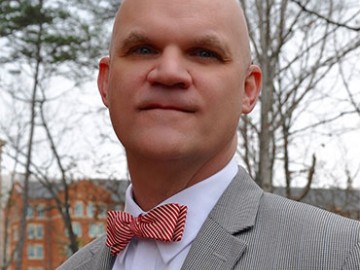Change leadership: Communications best practices

Key takeaways
- Properly communicating change in higher ed is critical
- Start talking about potential change early and make it personal
- Build a sense of urgency
In part one of this blog series, we examined why higher education needs change leadership, in part two we looked at a few change leadership models, and in part three, we covered what makes change leadership different for higher education. Here in the final part of the change leadership series, we’ll take a look at best practices for communicating change.
In the previous blog post, I explained why change leadership in higher education is markedly different from change leadership within the corporate world. An important piece of that puzzle is that there is an intrinsic emotional component for higher ed employees. There’s an expectation that employees—as well as students and faculty—have a voice in what happens on campus, and that everyone shares a passion for one goal: education. When you work at a large corporation, you may not feel that same sense of emotional or shared connection.
So what does that mean? It means that properly and effectively communicating change in higher education is critical. You’re not just dealing with employees—you’re dealing with people who are emotionally invested with their workplace and its culture. And an ineffective communication strategy in this environment can be disastrous.
Timing is everything
Probably the number one rule when communicating change in higher education is this: Start talking about potential change early.
In part two of this blog series, I talked about various change models that higher ed institutions might use when implementing a change leadership programme. One of those is the Kotter method—which stipulates that communicating early is the foundation of successful change leadership.
By taking this approach, you are, in essence, setting the context for the change and building a case for it.
No one likes to feel as if a change has been imposed upon them from someone higher up in the organizational tree. However, there are times when a decision or change must be communicated or enacted relatively quickly, and it’s impractical to open up multiple lines of input. In those cases, it’s essential to directly and honestly communicate how the decision was made, and why. Did the president unilaterally make the decision? Did the cabinet or leadership team discuss in a formal meeting? Did a committee make a recommendation? Were there focus groups, or open forums for input? Disclosing how the decision was made—owning it if you will—sets the stage for the next part of the process, in which you explain the impact and outcomes of the impending change.
However, it’s important to note that a preferred approach to communicating change is to do so before the wheels have been set in motion. In other words, build a coalition for change by soliciting input. Within higher education, because of its culture and inherent ambiguity (see blog three), there are no central rallying points around change—such as, “We’ve got to increase profits.” Higher education is comprised of many different stakeholders with differing concerns—students seek one thing, faculty another, and so on. Seeking input from these groups before a decision has been made can make all the difference.
That’s because this approach to change leadership is about more than creating a sense of acceptance or getting people to adjust their thinking about impending change—it’s about allowing all stakeholders to feel that they’ve had a voice, or a chance to participate, in the process. Getting that input sooner rather than later can go a long way toward making change an easier, more streamlined process for everyone involved.
Getting personal
The second point in handling change in higher ed reflects back to the ADKAR model (part two), which argues that change leadership is best handled at the individual level.
Typically, a change isn't to benefit the employee. It's to benefit the outcome or an ultimate customer—or in the case of higher ed, the students. We ask faculty and staff to make sacrifices for the students, which is, of course, a lofty and laudable goal—but one that does not directly benefit the employee. So how do you most effectively communicate a change that will impact an employee? By getting personal.
Higher ed institutions (and corporations) love to send out emails to communicate change—they’re enamored with the transparency of that kind of communication. But it’s not the most effective method, nor is it particularly personal and engaging.
It may seem somewhat self-serving, but we want to motivate the employee by what's in it for him or her. Communicating change means helping each employee understand what he or she will personally gain from it. Will the change make their jobs easier? Is it going to reduce time on task? Will it reduce their time on mundane paperwork so they can spend more time on more complex—and more interesting—tasks?
Basically, this approach says, “Here is what you will get out of the deal.” And, conversely, the institution benefits from having employees who are engaged in the change, motivated by it, and behind it—even if it’s for their own reasons.
The idea behind this approach is to simply shrink the change to an individual level. Institutions are large and complex, so anytime you can humanise a change—that is, bring it down to the individual’s level—then it makes the road to change far less rocky.
That also means communicating the concept that the change is not going to completely and utterly transform the institution into something unrecognizable overnight. As discussed in previous blogs in this series, change happens incrementally at higher ed institutions. But it’s sometimes important to remind employees that a change doesn’t mean the institution is changing its values, abandoning its mission statement, or giving up on how students are educated: Those values still apply; the mission statement is essentially the same; how we define success may evolve, but the students always come first.
Building a sense of urgency
Now, keeping all of these approaches in mind, here’s where the rubber meets the road. When communicating an impending change—regardless of size or complexity—it’s important to convey a sense of urgency.
Why is that? Because without adequately communicating urgency, any kind of proposed change is doomed to fail, because the will to push that change forward simply won’t be there. The most effective communicators of change know this: they place the change in context, explain why it needs to happen so the organization (whether higher ed or corporate) can adapt and grow to meet new challenges. It’s a two-part process—building a coalition for change also means creating a catalyst for that change.
Now, that’s certainly a challenge for higher ed leaders, because higher education is not like the corporate world. Obviously, college and university presidents can’t simply say, “We need to change so we can sell more widgets and our stockholders will be happy.” Rather, it behooves higher ed leaders to create a sense of urgency around the need to evolve, without mistakenly giving the impression that something earth-shattering is occurring, or that higher ed employees’ lives are about to be turned upside down. That’s a tricky balancing act.
As previously mentioned, one of the more effective ways to communicate change is to scale it down and make it personal. I encourage higher ed presidents to get out there in front of people—go to the faculty senate, go to staff council, conduct a campus “town hall” meeting—and have an open and frank discussion about the impending change. A website that offers updates or emails about the change is absolutely secondary to the president or provost putting in face time with the people on campus who will be directly affected by the change.
One of the mistakes we sometimes make is an over-reliance on mass communication and a misplaced belief in how effective that really is. Higher ed culture is really driven by individual attitudes, and the only way to change those attitudes is to reach out to people as individuals. You're trying to build momentum and urgency—and the only way to do that is through a two-way dialogue.
Part of that “two-way dialogue” must include consistent messaging. Leaders and managers have to possess the right tools so that they communicate the president or provost’s message clearly and accurately. A communications plan that includes talking points, PowerPoint presentations, and so on will help those managers and supervisors discuss the impending change with their respective teams.
Implementing a change management programme is only the beginning—one of the most difficult challenges is figuring out how to communicate that change to all stakeholders and do so effectively without alienating core constituencies. After all, attempting to make any change without adequately communicating what’s happening is a surefire way to sabotage your own efforts.
There’s no question that higher ed is facing some real challenges—but the decades ahead will also bring opportunities. It’s incumbent upon today’s higher ed leaders to be ready for those challenges and poised to make the most of those opportunities as well. That’s why change leadership is more important than ever. Hopefully, the advice and tools offered throughout this blog series will provide a roadmap to help leaders navigate the road ahead.
This is the final blog of a four-part series. Catch up on part's 1-3:


